Sinology: Has the China Collapse Finally Arrived?
By Andy Rothman
China has been on the verge of a hard landing for many years, according to some analysts. Will they finally be right in 2019? In this issue of Sinology, I explain that in the fourth quarter of 2018, China's economic deceleration was not significantly sharper than I expected, and several policy changes should lead to stronger activity and market sentiment in the second half of this year. A hard landing is still not on the horizon.
There was not a sharp slowdown in the last quarter
Everyone paying careful attention to China should have expected the year-on-year (YoY) growth rates of almost every aspect of the economy to slow a bit last year, as that has been a consistent pattern for about a decade. The economy has become so large, and growth rates were so fast for so long, that this deceleration is inevitable.
What has worried many observers, however, is the perception that in the last quarter (4Q18), China's growth rate slowed much more sharply than expected. With final data for 2018 now in hand, let me explain why that perception is not accurate.
Still the world's best consumer story
Let's start by examining the largest part of China's economy—consumption.
Income growth is, of course, the foundation of consumer spending, and in 4Q18, inflation-adjusted (real) income growth slowed a bit, to 6.2% YoY, down from 6.9% in 4Q17. That degree of slowdown was within my expectations, and it is worth noting that last quarter's pace was roughly the same as the 6.3% recorded in 4Q16.
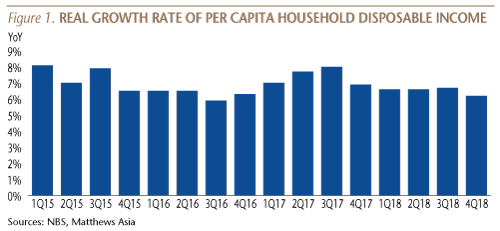
One data point that did surprise on the downside in the last quarter was the nominal growth rate of retail sales of consumer goods by larger firms, which slowed to 2.6% from 7.3% in 4Q17. But, this sharp deceleration was due almost entirely to a collapse in auto sales, which fell by 8.3% YoY, in contrast to a rise of 4.4% during 4Q17.
This new car collapse was, however, largely the consequence of a temporary tax cut from late 2015 through the end of 2017, which brought forward demand—retail sales of autos by larger firms rose 10.1% in 2016 and 5.6% in 2017—rather than being a reflection of a lack of spending power or sentiment on the part of consumers. (For this reason, new car sales are likely to remain weak in 2019.)
In fact, nominal retail sales by larger firms excluding autos rose 7.7% during the last quarter, compared to 8.6% in 4Q17 and 8% in 4Q16.
Not a dramatic deceleration, especially when a sharp fall in global oil prices also contributed to slower growth in retail sales, as gasoline prices were down.
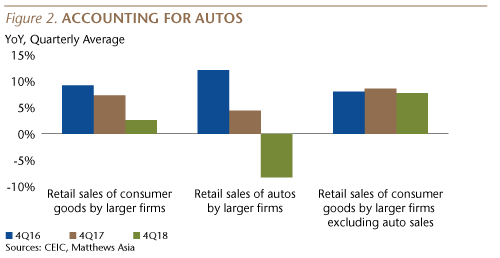
Adjusted for inflation, the growth rate of retail sales accelerated in December to 6.7% YoY, up from 5.8% in November and 5.6% in October, although down from 7.8% in December 2017.
Here is another perspective: household consumption rose 8% YoY in 4Q18, up from 6.1% during 4Q17, despite the sharp slowdown in auto sales last year. This acceleration reflects the rising share of consumer spending on services, as well as the strength of spending on services.
Services now account for 44.2% of household consumption, up 1.6 percentage points from a year ago.
And the household consumption data covers the full range of spending on services, such as education, health care, rent, travel and entertainment, while the services spending captured by the retail sales data is limited to only restaurant dining and other food-related services. (Retail sales covers spending by companies and government agencies, while, of course, household consumption data—which is only published quarterly—excludes those organizations.)
Another reflection of the health of the consumer story is that final consumption of goods and services accounted for 76.2% of China's GDP growth in 2018, up from a 57.6% share in 2017 and a 47% share in 2013.
With the investment (gross capital formation) share of GDP growth falling to 32.4% last year, down from 55.3% five years earlier, it is clear that there has been significant progress in the rebalancing of the Chinese economy.
It is also worth noting that the contribution to GDP growth from net exports (the value of a country's exports minus its imports) was -8.6% for all of 2018, making clear that China is no longer an export-led economy. (Over the past five years, the average annual net export contribution to China's GDP growth was -1.3%—something to remember when thinking about the impact of a possible trade war.)
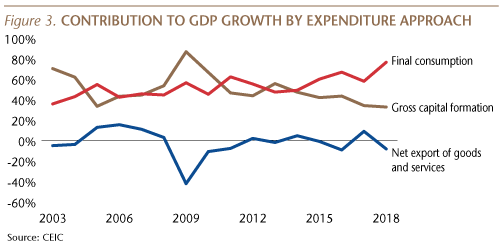
Manufacturing, excluding autos, is healthy
The value-added of China's industry grew just slightly less rapidly in the last quarter: 5.7%, compared to 6.2% in 4Q17 and 6.1% in 4Q16. And even that modest deceleration was due largely to the collapse in auto sales, which led to sharply lower auto production. The value-added of the auto industry declined by 2.7% during the last quarter, down from a rise of 10% in 4Q17 and 17.9% in 4Q16. This reflects that, aside from autos, China's manufacturing sector remained healthy in the last quarter.
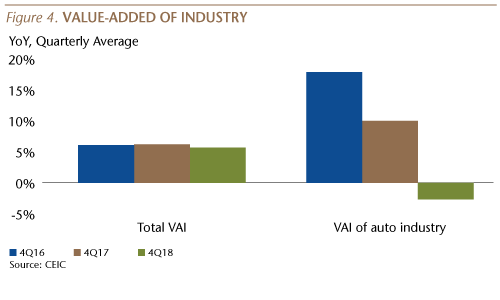
Manufacturing and property investment is healthy
Total fixed asset investment (FAI) rose 7.2% YoY in the last quarter, up from 6.4% a year earlier. Manufacturing capital expenditure was particularly strong in the last quarter, up 11.6% compared to 6.6% a year ago. Investment in real estate was also strong, despite slower growth in new home sales, because inventory levels were very low and developers expect purchase restrictions to be relaxed in the future. We estimate that real estate investment rose 8.1% in 4Q18, compared to a rise of only 0.1% in 4Q17.
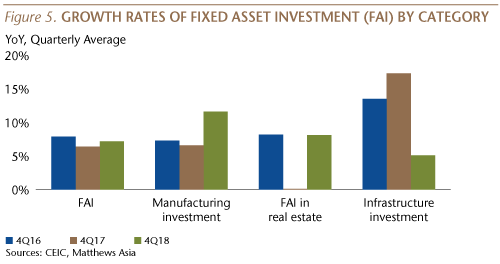
The other major component of FAI is spending on public infrastructure. The central government engineered a sharp slowdown in this space during the first three quarters of last year, as steps were taken to rationalize local government spending, but the growth rate recovered a bit in the fourth quarter, up 5.1%, compared to 17.3% a year ago. With a modest fiscal stimulus and a very weak base, the YoY growth rate of infrastructure is likely to provide a boost to overall economic activity this year.
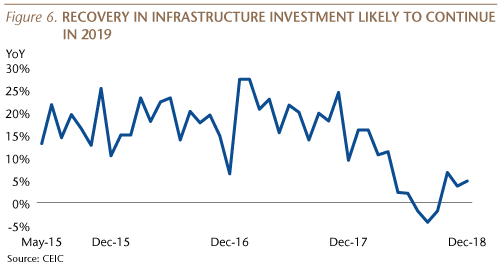
Growth wasn't bad, but sentiment was terrible
Since the degree of economic growth deceleration last year was largely within my expectations, why was market sentiment in China abysmal? I think there were four key reasons.
The most important driver of pessimism was fear of a trade war with the U.S. Domestic investors told me they were concerned about far more than just a disruption of shipments to China's top export market. They worried that President Trump might escalate the conflict beyond tariffs, limiting the ability of Chinese to study in the U.S., or banning Chinese imports of American semiconductors, which are the foundation of China's tech sector. The negative consequences of a possible cold war-style relationship between the world's two largest economies weighed heavily on domestic sentiment last year.
The second driver of pessimism was concern that during the first three quarters of last year, Chinese leader Xi Jinping voiced strong support for state-owned enterprises (SOEs), while expressing little love for the private firms, which account for most employment and all net new job creation in China. This was, however, a change in rhetoric, rather than in policy. In fact, investment by private firms rose 8.7% last year, up from 6% in 2017.
But entrepreneurs told us that Xi's apparent disregard for their contributions to China's economy left them apprehensive about the future.
A third factor was the unintended consequences of the government's efforts to de-risk the financial system. Shadow banking was cut sharply last year, with shadow loans outstanding down by almost 11% YoY as of December, in contrast to a rise of 15% through December of 2017. Total credit rose by about 10% last year, but the composition of the new flow changed: traditional bank loans accounted for 81% of new credit, up from a 51% share in 2013 as shadow banking was curbed. There was a similar clampdown on peer-to-peer lending. While these changes are good for the long-term health of the financial system, they created short-term pain for many private firms, who were among the largest recipients of shadow credit.
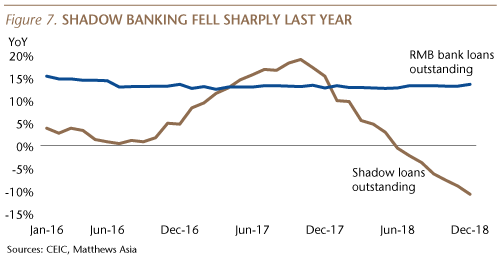
A fourth factor behind last year's pessimism was a cloud of regulatory uncertainty. Policy changes were often made abruptly, with little transparency or clear guidance on how they would be implemented at the local level, leading to risk aversion. Examples included enforcement of environmental protection rules, collection of social security taxes, and price controls for generic drugs.
Sentiment is likely to improve in the second half of this year
In the first half of this year, sentiment is likely remain weak, contributing to slightly weaker macro numbers. But there are several reasons to expect sentiment and economic activity to strengthen in the second half.
The first reason is that I expect a 1H19 resolution to the short-term trade dispute between the U.S. and China. Trump seems to believe that resolving this problem and lifting his tariffs on Chinese imports is important to his re-election prospects, and he has therefore adopted a more realistic negotiating strategy, dropping his irrational focus on the bilateral trade deficit as well as demands for Xi to make deep structural changes, such as eliminating his industrial policies and support for SOEs. I think Xi recognizes that Trump's remaining demands, including better market access for American firms and stronger protection for intellectual property rights, will contribute to China's economic progress, and Xi also wants to avoid a conflict that could escalate into a tech war, jeopardizing China's access to US semiconductors. A Trump—Xi deal will not resolve the longer-term challenges in the bilateral relationship, but it will lift short-term fears of an escalating trade war.
The second reason to expect better sentiment in China is that Xi has already pivoted away from his rhetorical embrace of SOEs, with recent public statements expressing support to entrepreneurs. His banking regulators have also announced a series of measures designed to boost lending to private firms. While it isn't clear how effective those measures will be, the impact on entrepreneurial sentiment should be apparent in the coming quarters.
Modest easing of monetary and fiscal policy is a third reason for optimism this year. China's banking regulators have indicated that they will take steps to mitigate the impact of the shadow banking crackdown, including increasing interbank liquidity, which will lower interbank rates. Mortgage rates have already begun to decline. This will be accompanied by modest fiscal policy easing, including further tax cuts and a small boost to infrastructure spending. Because the economy remains reasonably healthy, these policy fine-tuning measures will fall far short of a dramatic stimulus, and their objective is to boost sentiment and ensure the macro deceleration remains gradual, rather than to reaccelerate growth.
I also expect policy fine-tuning in the residential property sector. New home sales were soft last year, but this was expected, as more than 100 cities enforced policies designed to deter sales and keep prices from rising. Those policies worked: new home sales rose 2.2% by square meter last year, after rising by 5.3% in 2017 and 22.4% in 2016. This year, I expect Beijing to allow some of those 100 cities to relax (but not eliminate) their housing purchase restrictions, which will release some pent-up demand, but I do not expect a broader relaxation of house purchase restrictions. This year, Chinese are likely to buy another 12 million new homes, with a minimum of 30% cash down.
Finally, although regulatory uncertainty will remain a fact of life in China for many years to come, investors are likely to see more clarity on some specific issues, including a relatively benign impact on company profits from more effective collection of social security taxes.
All of these factors, along with relatively low valuations in the A-share market, are likely to result in better sentiment among domestic investors in the second half of this year.
Regards,
Andy Rothman
Investment Strategist
Matthews Asia
Sources: Matthews Asia, CEIC, National Bureau of Statistics (NBS) and CLSA
Back to Thought Leadership